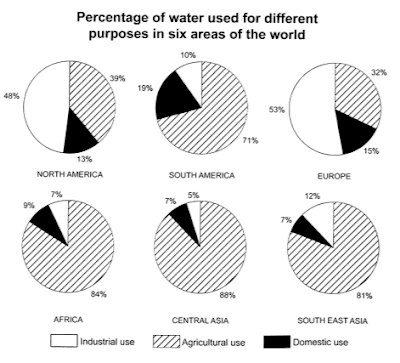How would you answer this Cambridge 11 Test 1 Writing Task 1 question?
Cambridge 11 Writing Task 1
IELTS Writing Task 1 (Academic) tests your written communication skills - how well you can report/describe information.
Cambridge 11 Writing Task 1 (Test 1)
You should spend about 20 minutes on this task.
The charts below show the percentage of water used for different purposes in six areas of the world. Summarise the information by selecting and reporting the main features and make comparisons where relevant.
Write at least 150 words.
International English Language Testing System
How would you answer this IELTS 11 Writing Task 1 question about water used for different purposes?

Writing Practice for IELTS Task 1: Sample Answer
(useful vocabulary is highlighted)
The pie charts illustrates water usage in six different regions around the world. Notably, Europe consumes the greatest quantity of water for industrial purposes, closely followed by North America. The other four regions use significantly less water for industrial purposes, but use water predominantly for agriculture.
Both North America and Europe consume much less water for use in agriculture than the other four regions. In contrast, in three of those regions, Africa, South East Asia and Central Asia, water used for agriculture accounts for more than 80% of total water consumed in each region. Africa, South East Asia and Central Asia have considerably similar water consumption profiles. Interestingly, South America, while predominantly using water for agriculture, actually consumes more water for domestic purposes than both North America and Europe.
The data provided clearly illustrates the difference between the heavily industrialized economies of North America and Europe, and non-industrialized economies such as those of South America, South East Asia and Central Asia in terms of water consumption.
IELTS Writing Practice, vocabulary, fill in the blanks
How to answer IELTS Writing Task 1 questions
Summarizing and describing information in several pie charts.
IELTS writing Task 1 is designed to test your ability to summarize and describe information accurately.
In task 1, you might be given one or more pie charts. You need to carefully read the question and then write a summary of the information in the chart(s).
Here are some tips on how to effectively answer IELTS writing task 1 questions that involve summarizing and describing information in a pie chart or several pie charts.
- Read the question carefully and make sure you understand what it is asking you to do.
- Take a few minutes to look at the chart(s) and get an overview of the information shown. Make sure you know what each section represents.
- Now, start by writing a brief introduction that introduces the topic of the chart(s) and gives an overview of the main points/trends.
- Next, write a paragraph for each of the pie charts. In each paragraph, describe one data point/trend that you see in the chart. Use specific language and numbers to support your descriptions. Read more about how to describe data in a chart.
- Finally, summarize the main points of your answer. Remember to write at least 150 words for your answer. If you write less than this, you will lose marks.
NOTE: It is also important to use a variety of vocabulary when describing the information in the pie charts. Here are some suggested words and phrases that you can use when doing writing practice for IELTS:
- percentage / proportion / share / amount
- rise / increase
- fall / decrease
- remain stable / constant
- trend
- peak
- first/second/third, most
- overall / in general
Following these tips will help you effectively answer IELTS writing Task 1 questions that involve summarizing and describing information in a pie chart or several pie charts.
Just remember to take your time, read the question carefully, and use specific language and numbers to support your descriptions.
Good luck with your IELTS exam preparation!
Test 2 Test 3 Test 4